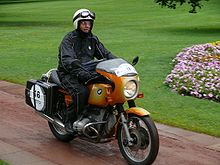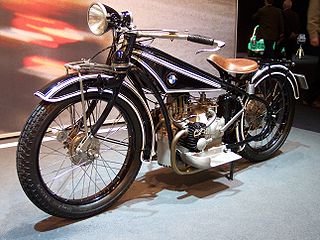
BMW's motorcycle history began in 1921 when the company commenced manufacturing engines for other companies. BMW's own motorcycles—sold under the BMW Motorrad brand—began in 1923 with the BMW R 32, which was powered by a flat-twin engine. Production of motorcycles with flat-twin engines continues to this day, however BMW has also produced many models with other types of engines.

The Kawasaki Ninja ZX-7R was a 750cc motorcycle in the Ninja sport bike series from the Japanese manufacturer Kawasaki produced from 1989 until 2003
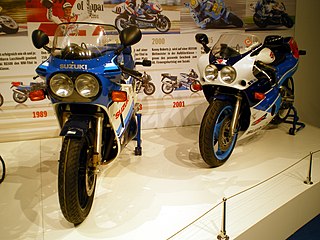
Suzuki GSX-R is a series of sports motorcycles made by Japanese automotive manufacturer Suzuki since 1984.

AMA Superbike Championship is an American motorcycle racing series that has been run every year beginning in 1976. For most of its existence it has been considered the premier motorcycle road racing series in the United States. It is sanctioned by the AMA American Motorcyclist Association since its inception, and the promotion of the series has been licensed to several organizations over the years. Since 2015 the series has been run and promoted by MotoAmerica, who also manage several other AMA professional road racing championships, including the popular 600cc Supersport class.
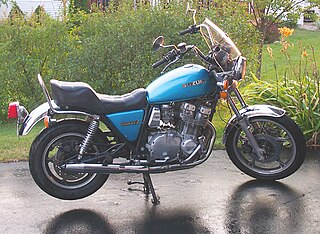
The Suzuki GS series was Suzuki Motor Corporation's first full range of 4-stroke powered road motorcycles, having previously almost exclusively manufactured 2-stroke machines. Suzuki had produced the 4-stroke Colleda COX 125cc and 93cc 4-stroke single-cylinder machines in 1955 however the rest of Suzuki's production from 1952 to 1976 had been increasingly sophisticated two-stroke road machines, whose ultimate expression was the 750cc 3-cylinder water-cooled GT750.
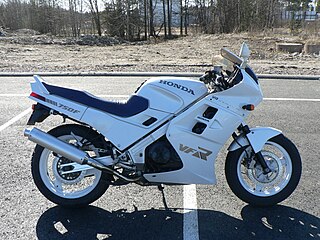
The Honda VFR750F is a motorcycle manufactured by Japanese automobile manufacturer Honda from 1986 to 1997. The motorcycle is a very sporty sport tourer, and is powered by a 750 cc (46 cu in) V4 engine developed from the earlier VF750F models. The VFR was announced in 1986, after an initial press viewing at the 1985 Bol d'Or.

The CB700SC Nighthawk 700S is a carbureted, air-cooled, in-line four-cylinder motorcycle marketed by Honda solely in the United States for model years 1984–1986, with a standard or neutral, upright riding position, It was a downsized version of the CB750SC Nighthawk S and was meant to circumvent the tariff laws of 1983-1987. Features included a 6-speed transmission, hydraulic valve lifters, shaft drive, front bikini fairing, gear indicator, 16" wheels and an introductory list price of $3,398.
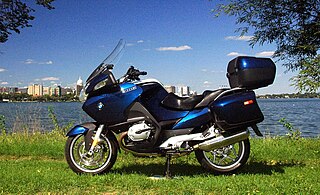
The BMW R1200RT is a touring or sport touring motorcycle that was manufactured from 2005 to 2019 by BMW Motorrad to replace the R1150RT model. It features a 1,170 cc (71 cu in) flat-twin engine with a six-speed gearbox and shaft drive.

For the WWII-era motorcycle, see BMW R75

Reginald Charles Pridmore III is an English former professional motorcycle racer. He competed in British and American motorcycle road racing events from the early 1960s until the late 1970s, most prominently as a three-time AMA Superbike National Champion. Pridmore won the inaugural 1976 AMA Superbike Championship riding a BMW motorcycle at a time when BMWs were considered to be outdated touring motorcycles rather than proper racing motorcycles. In 2002, he was inducted into the AMA Motorcycle Hall of Fame. He is the father of retired AMA racer Jason Pridmore.

The KTM 1190 RC8 was a supersport bike made by KTM. The first generation 2008 model had a 1,148 cc (70.1 cu in) V-twin engine and was the Austrian manufacturer's first-ever Superbike design. The RC8 model was supplemented with RC8 R models one year later in 2009 and the RC8 designation had its last year of production in 2010. Models from 2009 through to 2013 use a 1,195 cc (72.9 cu in) V-twin engine with a twin spark per cylinder technology debuting on the 2011 model, which is a rare supersport bike.

The Yamaha FZ750 is a sports motorcycle produced by Yamaha Motor Corporation between 1985 and 1991. The FZ750 is notable for several reasons, perhaps the most radical being the 5-valve cylinder head. This became something of a Yamaha trademark. The FZ750 would be the first bike in the Genesis design concept.

BMW S1000RR is a race oriented sport bike initially made by BMW Motorrad to compete in the 2009 Superbike World Championship, that is now in commercial production. It was introduced in Munich in April 2008, and is powered by a 999 cc (61.0 cu in) transverse inline four-cylinder engine redlined at 14,200 rpm.
BMW Motorrad is the motorcycle brand and division of German automotive manufacturer, BMW. It has produced motorcycles since 1923, and achieved record sales for the fifth year in succession in 2015. With a total of 136,963 vehicles sold in 2015, BMW registered a growth of 10.9% in sales in comparison with 2014. In May 2011, the 2,000,000th motorcycle produced by BMW Motorrad was an R1200GS.

The Moto Guzzi Le Mans is a sports motorcycle first manufactured in 1976 by Italian company Moto Guzzi. It was named after the 24-hour motorcycle endurance race at Le Mans in France. The Le Mans designation was first used for an 850 prototype, based on the V7, displayed at Premio Varrone in late 1972.

The BMW F series is a family of parallel-twin engine dual-sport motorcycles manufactured in Berlin, Germany by BMW Motorrad. Launched in 2008, the range comprises the F650GS, F700GS, F800GS, and F800GSA. In 2012, the F700GS replaced the discontinued F650GS, and in 2013, the F800GSA was introduced with a 24-litre fuel tank and a larger front fairing and screen. The F800GT and F800S both have belt drive.

The Ducati ST series is a set of Italian sport touring motorcycles manufactured by Ducati from 1997 through 2007. In order of release, the series comprised five distinct models: the ST2, ST4, ST4S, ST3, and ST3S. Intended to compete with other sport-tourers such as the Honda VFR, the ST Ducatis had a full fairing, a large dual seat and a relaxed riding position for both rider and pillion. The ST bikes had a centre-stand, and could be fitted with optional matching luggage.

The BMW R1100S is a sports motorcycle that was manufactured by BMW Motorrad between 1998 and 2005. Introduced some 25 years after the R90S, the company's first sports bike, the R1100S was the first BMW bike having clip-on handlebars, rearset footrests and a removable cowl to cover the pillion seat. Producing nearly 100 hp, it has been described as a "sporty sports-tourer".

BMW R100, with variant models designated by T, S, CS, RS, RS Classic, RT, RT Classic, TIC, TC, R and GS is a BMW motorcycle series, using a two-cylinder four-stroke boxer engine of 980 cc capacity. Model production began in 1976, with a premature shutdown and subsequent restart in 1985, and final completion of the series in 1996.

The BMW R60/6, R75/6, R90/6 and the sport model BMW R90S form a range of boxer twin motorcycles that were manufactured in Berlin, Germany, by BMW from 1974 to 1976. The "slash six" models departed from the earlier "slash five" slightly. First, the smallest displacement changed from 500cc to 600cc. A sport model was offered, as were disc brakes for the first time. Additionally, the tank design was changed to remove the chrome trim panels, and the gauge pod was moved from the headlight housing to its own assembly over the housing.


